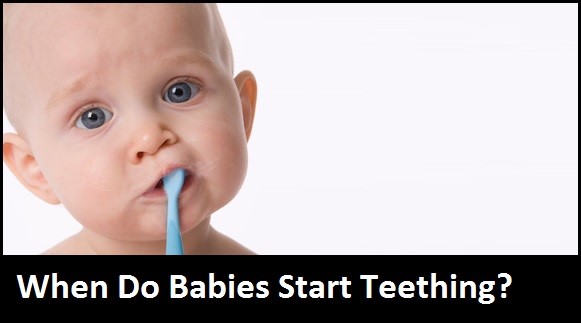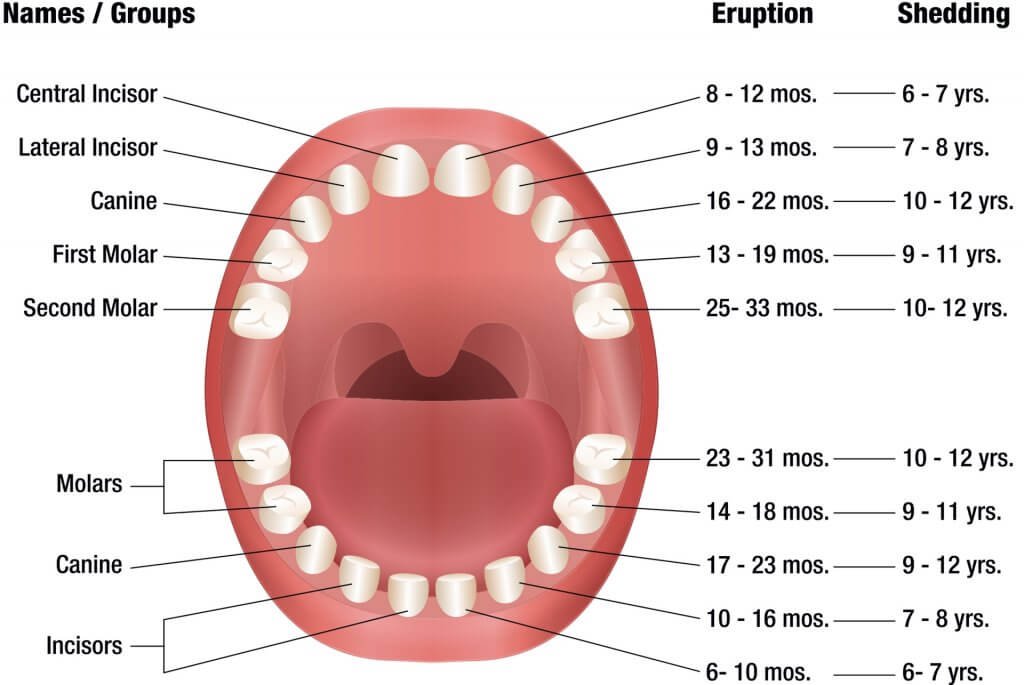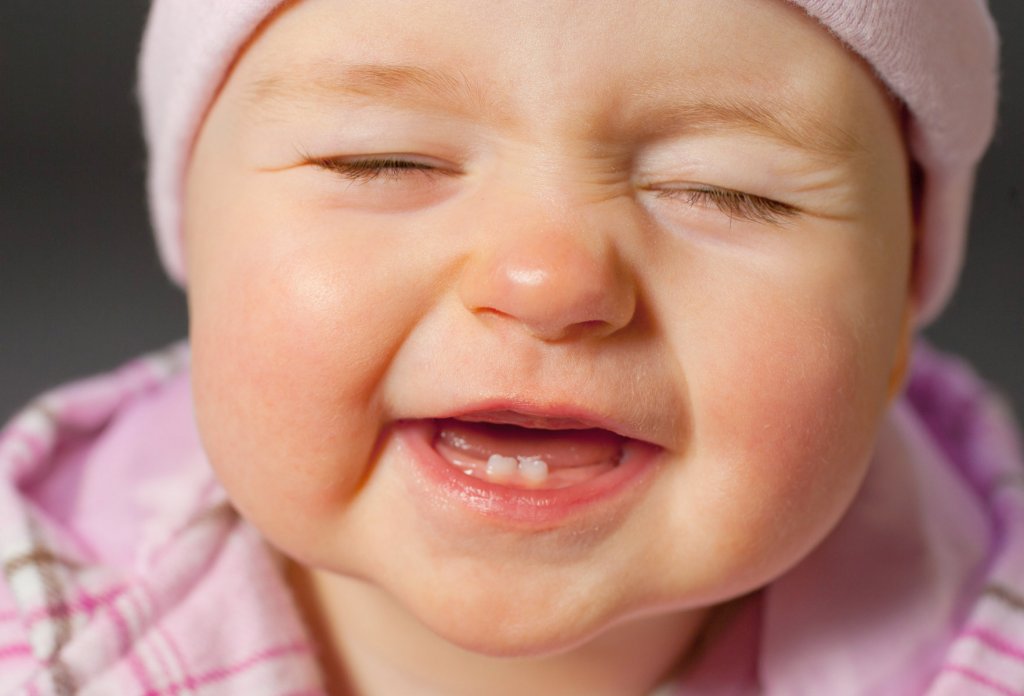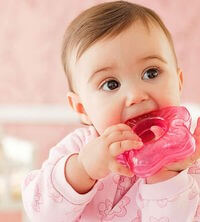
The journey of a baby from a bundle of flesh to a real grown child is not an easy one. These little drops of heaven go through a lot of changes physically and mentally. One of the first ever change that happens in the body of an infant is the emergence of the teeth. When the pearly whites are emerging they make a huge variance in the entire body of the baby.
The real question is when do babies start teething? The grand painful entry of a tooth may start as early as 3 months or it may emerge after their first birthday. The average time for the first tooth to appear is when the baby completes 6 months.
Table of Contents
When do babies start teething?
The appearance of teeth is an important milestone in the development of a baby. The gummy grin undoubtedly gives an adorable look to a little baby, but when the cute row of pearly whites emerges, they make the baby’s smile even cuter.
The emergence of a baby’s first tooth depends on the family history of teething. In most cases, babies’ teeth break out between the 4 to 6 months, while for some it may be earlier or later than that. There are some cases where some toddlers won’t have their first tooth up until 18 months which could be normal yet should see their pediatrician to confirm the existence of teeth in the mouth.
Baby Teething Chart:
 Babies have their tooth buds developed even before they’re born. When these buds cut through the gums, teeth appear. The emergence of teeth doesn’t happen all at once. They go through a process age wise given below.
Babies have their tooth buds developed even before they’re born. When these buds cut through the gums, teeth appear. The emergence of teeth doesn’t happen all at once. They go through a process age wise given below.
1. Between 6 and 12 months, the central incisors, i.e., the teeth right in the center of the jaw on the top and bottom appear
2. From 9 to 12 months, the lateral incisors, i.e., the teeth next to the central incisors
3. Around 16 to 22 months the canines emerge
4. From 13 to 19 months, the first molars erupt
5. Finally, from 25 to 33 months, the second molars appear
By the age of three years, all of the primary teeth i.e. a full set of 20 baby teeth will be developed. In very rare cases, due to some medical conditions forming of teeth is prevented by the body.
The emergence of teeth will help the baby to eat a proper diet. Until then the baby had a diet of eating everything in the form of puree. Tooth inception gives the baby an ability to bite into textures food like apple or plum, chew vegetables which has an indirect influence on weight gain, strengthening of immunity, improving bone health, and development of the brain. The biting is also an exercise to build the underlying oral-motor musculature which helps for speech development.
Signs and Symptoms of Babies Start Teething:
The sequence of erupting teeth can be either effortless or unbearable. Most babies show teething symptoms by 2-3 months even before a tooth comes up which is quite weird but natural. The symptoms could be brutal if it is causing a lot of discomfort for the baby.

How to tell if a baby is teething? Babies can be fussy about anything. Even the tiniest discomfort triggers them to cry. The following symptoms are to be looked at that tells if the baby is teething.
1. Drooling
Teething stimulates drooling. Some extra amount of saliva is created t by the body to lubricate the tender and bulging gums. From around ten weeks or 3-4 months, the water fountain starts in the baby’s tiny mouth. The baby’s clothes are constantly soggy because of the excess drool. A bib may be tied around the neck of the baby to make her more comfortable and clean. Also, the baby’s chin has to be gently wiped to clear off the drool to saver her from chapping.
2. Teething rash
A teething baby constantly drools; this dripping may cause irritations like chapping, redness and rashes around the baby’s mouth chin and even on the neck.
3. Biting more than usual
This teething symptom of teething sends baby into a bite-fest! They tend to bite on anything that comes in their way- from plastic spoons to toys, from their own fingers and toes, from bed sheets to their bibs, even the mother’s flesh when breastfeeding.
4. Fussier especially at night
Teething process disturbs the sleep of the infants. They do not sleep through the night and start to wake up several. Teething pain hurts the baby more at night because there are fewer distractions in the quiet hours of the night.
5. Troubles with sleeping patterns
Another symptom of teething is that it irritates the night time slumber of the baby. The babies will usually nap less and wake up earlier in the morning. All of their playtimes is involved with the teething pain.
6. Fever, rashes, and diarrhea
The eruption of teeth indicates a slight fever under 100 degrees in the babies when teeth are about to emerge. The occurrence of extra drool causes facial rashes. Sometimes babies even suffer from diarrhea.
7. Diminished appetite
Teething pain triggers the sore spots inside the mouth. Because of this, they try to avoid eating.
8. Pulling ears; rubbing chin and cheeks
Teething pain creates a pressure inside and around the baby’s mouth. Babies know how to handle these. They ease out this pain creating a counter pressure by pulling and rubbing their jaw.
9. Coughing and/or gag reflex
Too much of drooling while teething will either flow out of the baby’s mouth or pool up at the back of their throat. All that pooled up drool make babies gag and cough. Unless there are signs of cold, flu or allergies this condition is normal.
10. Crying
The emergence of the first ever teeth hurts the most. They suffer from a great deal of pain due to the inflammation of the tender gum tissue. As they can’t talk, they whine and whimper.
Teething Conditions That Could be Serious:
Premature babies and babies of low-birth-weight may experience a delay in eruption of the first tooth. If a sign of sprouting a tooth is not seen even by the first birthday, a pediatrician has to be consulted. If the baby is ill and teething symptoms are seen, gums have to be inspected. If they’re swollen and at least one tooth-size lump is noticed, it means teething’s in progress.
Apart from the above symptoms if any of the following symptoms are present, medical help has to be sought:
1. High fever above a 100 degrees
2. Diarrhea or vomiting
3. The gums aren’t pink but red or blue which indicates an eruption cyst. Although most cysts are non-threatening it’s best to have them checked
4. Lumps and lesions on the gums
Baby Teething Remedies
It is true that babies look super cute when they start developing teeth. The two bunny tooth and that innocent yet naughty smile is a lovely picture. But the pain makes the babies cranky and irritated. Some home remedies may be tried to pacify the crying baby and soothe it from the pain.
1. Frozen food in a mesh feeder
A remedy that is effective in relieving pain and also a tasty treat. A safe mesh feeder may be filled up with crushed up frozen bananas, apples, and carrots and then gnawed on by the teething baby. The safe mesh feeder prevents any choking hazards.
2. Peeled ginger root
Ginger, with its natural anti-inflammatory properties, helps in relieving teething pain. It soothes the nerve endings present in the gums. Rubbing a slice of a peeled ginger over the baby’s gums for around 2-3 minutes gives the strongest effect.
3. Cloves
Ground cloves are an effective remedy for calming the aching gums. The oils in cloves have warming and numbing properties. Make a paste of ground cloves with water, coconut oil, or unsalted butter, and chill in the fridge. This frozen paste may be rubbed on the gums. Even the Clove Essential Oil works great.
4. Freezing a washcloth
The most effective and rather cheapest remedy is the frozen washcloth remedy. A clean washcloth soaked in water must be put in the fridge or freezer for about half an hour. The baby can bite and suck on the frozen washcloth. The texture of the fabric and the numbing effect of the cold is a perfect combo to calm the aching gums.
5. Cool Spoon
A clean steel spoon can be chilled in the freezer and given to the baby to chew on
6. Counter pressure
Mama or papa’s clean finger, teething toys with soft edges, wet toothbrush without toothpaste may be rubbed firmly on baby’s gums. This provides some soothing counter pressure.
7. Cold drinks
After six months when water could be given to the baby, when teething starts, a bottle of cold water offers a chilly relief to achy gums. If the baby doesn’t take water from the bottle, ice-free water may be given in a cup.
8. A Teething Mitt

The baby will realize very quickly that chewing on its own fingers and toes, a toy etc. helps in relieving teething pain. So, something safe must be given to chew on so dirt or germs will not be taken in by the baby. Good quality teething toys made of soft, BPA-free plastic, rubber, cloth or wood may be given to chew on. It saves the baby from potential choking hazards.
9. Vanilla extract
Vanilla reduces the baby’s anxiety as it contains the soothing agent. Also, the extract creates a warm, comforting sensation. The vanilla extract may be applied to the baby’s gums by dipping a cotton swab.
10. Homemade fruit Popsicle
Homemade Popsicle made from natural, organic fruit juice is a safe way to provide relief to the baby. When the baby chews on the cold, hard Popsicle, it will temporarily numb the pain in the gums.
11. Breastfeeding
Breastfeeding is a comforting remedy for teething in young infants. If breastfeeding irritates the baby, a slow flow sipper cup filled with breast milk may be given.
12. Warm bath
A warm bath will help the baby to relax their body. It provides a distraction from the constant discomfort. A warm bath takes the baby’s mind off from the teething pain as it offers a change of scenery.
13. Homemade rice pouches
Babies love the texture of rice. Homemade rice pouches made by placing one tablespoon of raw rice in the middle of a washcloth come handy. The washcloth must be tied with a rubber band before keeping it in the freezer. After removing it from the freezer the pouch must be wet a little before giving to the baby to hold and chew.
14. Facial massage
Teething babies will have delicate tissues and tender gums. They can be soothed by gently rubbing the baby’s face, jaw, and gums in a circular motion.




























